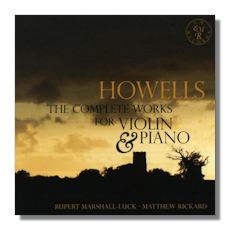
The Internet's Premier Classical Music Source
Related Links
- Howells Reviews
- Latest Reviews
- More Reviews
-
By Composer
-
Collections
DVD & Blu-ray
Books
Concert Reviews
Articles/Interviews
Software
Audio
Search Amazon
Recommended Links
Site News
 CD Review
CD Review
Herbert Howells

Complete Works for Violin & Piano
- Sonata for Violin & Piano in B minor (1911)
- Sonata for Violin & Piano #1 in E Major, Op. 18 (1918)
- Sonata for Violin & Piano #2 in E Flat Major, Op. 26 (1917)
- Sonata for Violin & Piano #3 in E minor, Op. 38 (1923)
- Cradle Song, Op. 9 (1918)
- Three Pieces for Violin & Piano, Op. 28
- Country Tune (1925)
- Slow Air (1927)
- Lento, Assai espressivo
Rupert Marshall-Luck, violin
Matthew Rickard, piano
Recorded November 2013
English Music Records EMR-CD-19-20 2CDs 74:08; 60:48
Herbert Howells (1892-1983) was from Gloustershire and his early musical training (compositional and instrumental) was local. In 1910, at age 17 he attended the Three Choirs Festival in the cathedral there. On the program were Elgar's Dream of Gerontius and the first performance of Vaughan Williams Fantasia on a Theme of Thomas Tallis, which had been commissioned for the occasion. RVW, who conducted the premiere, actually sat with the young Howells and shared the Elgar score with him following his own performance. Michael Trend, in his The Music Makers, reports that Howells and his friend Ivor Gurney were so excited by the Vaughan Williams Fantasia that they could not sleep that night and paced the streets. Both Elgar and Vaughan Williams would be strong and longstanding influences on Howells, although his own style would be distinctive.
A year later, in 1911, Howells wrote the first work on this compilation, the B Minor Sonata. The piece helped him win a scholarship to the Royal College of Music, which he entered in May 2012. He studied with Sir Charles Stanford, with whom he got along remarkably well. (Trend suggests that few music students did.) Stanford performed Howells' first piano concerto in 1913 in the Queen's Hall, London.
All of the works on the first CD of this set are world premiere recordings, including the restored original version of the E Flat Major sonata, the Slow Air, and Country Tune. There is even an alternate opening of the B Minor Sonata for anyone who might be interested.
The B Minor Sonata is quite a substantial work, at over forty minutes, and there are seven or eight pages of notes about it (including a reproduction of the scratched out passage which Howells discarded) by Paul Spicer. Rupert Marshall-Luck annotates the other works. The opening quasi-recitative is slow, clear and brief. The movement it introduces has a pace which is varied in tempo – slow to moderate; it is melodic, long, and sometimes songful. The lovely middle movement begins and ends at quite a slow tempo and its mood runs from highly expressive to a faster and agitated middle section. The final movement, nearly as long as the first, has no fewer than eight tempo and expressive indications, from molto moderato e sostenuto to molto allegro e con passion. In between is music that progresses from solemn to tranquil, then fast and sometimes agitated, as well as returning to the opening pace. It is well worth hearing all this.
Howell's officially numbered Sonata for Violin and Piano #1 was completed in the last year of the Great War and – expressively – would seem to be something of an arc. It begins slowly and quietly for both instruments and has an ending which is slow, steady and calm (assai tranquillo). In between there is agitated rhythmic intensity and decisive-sounding expression which eases somewhat. The finale is slow and marked as stated. The whole work has duration of only seventeen minutes.
Sonata #2 was published later than #1 but written a year earlier. It is about ten minutes longer, and calmer in mood, if livelier in tempo. Both are in major keys. The opening and third movements of Sonata #2 are fast, as is most of the finale, following a lento opening. The beautiful, slow second movement is quite expressive. The last two movements are both quite rhythmic, the third marked with by pizzicato playing. The finale quickly turns from a very slow beginning to a very fast pace, and is very lively indeed at the end. The tempo does ease somewhat in between.
In Sonata #3 Howells returns to a minor key and to a three-movement whole. Its pace is generally fast, but the outer movements both end calmly. The middle movement is notable for including a passage for pizzicato playing on the violin with a minimal sort of piano accompaniment, followed by a clever return to the bow by the violin against a rippling piano accompaniment and then a return to the pizzicato violin and tapping of the piano. The finale is lively, rhythmical and expressive but with a very peaceful ending to the piece.
The seven short pieces, like the sonatas, all belong to Howells' early period. They are not just fillers, but definitely add to the appeal of this release, especially the three pieces in Op. 28 (1917-1920). The modal Pastorale is lovely, and would surely seem to reflect Howells' affinity to the spirit of Vaughan Williams. Luchinushka, a Lament founded on a Russian Folk Tune, begins with a simple and attractive melody. The piano is dominant and the piece picks up what I was moved in my notes to call more "oompth" later. The short "Chosen" Tune, actually with a place name designation associated with a view of the Cotswolds, has a further association with Howells' engagement to Dorothy Dawe. It has a broad and sweet melody. Cradle Song, according to the notes, "anticipates the lullaby in Britten's Suite for Violin and Piano, Op. 6."
Playing by both performers is strong, and the recording is excellent.
Strongly recommended.
Copyright © 2015, R. James Tobin





















